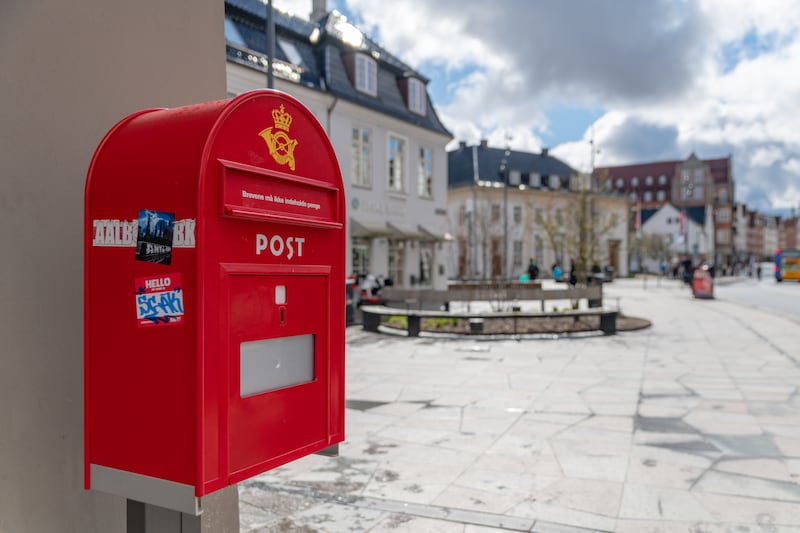On January 16th, 1922, Dublin Castle was apparently handed over to the new Irish Provisional Government led by Michael Collins. But the Provisional Government didn't take final possession of the Castle until the following August. So what happened in January?
The answer depends on what one means by Dublin Castle. If talking about the complex of buildings that had lain at the centre of Dublin since the 13th century, then they weren't physically handed over by the British on January 16th. If, on the other hand, one means Dublin Castle as a metaphor for British rule in Ireland, then that was certainly handed over on January 16th, 1922.
There was a prelude to what became known as the handover of Dublin Castle. On January 7th, Dáil Éireann narrowly voted to accept the Anglo-Irish Treaty signed in London the previous December and a week later, in the Mansion House, a separate meeting of “parliamentary representatives” (mostly pro-Treaty TDs) formally ratified the Treaty and agreed to appoint a Provisional Government to oversee the transition from British to Irish rule over the next few months. But the next steps were unclear.
Collins himself told a journalist from the Chicago Tribune: “I suppose our next step will be to walk into Dublin Castle, take possession and make a present of it to the Irish people. It won’t be done today, but perhaps Monday or early next week, and no arrangements have been made as to whether it will take the form of a public ceremony or not.”
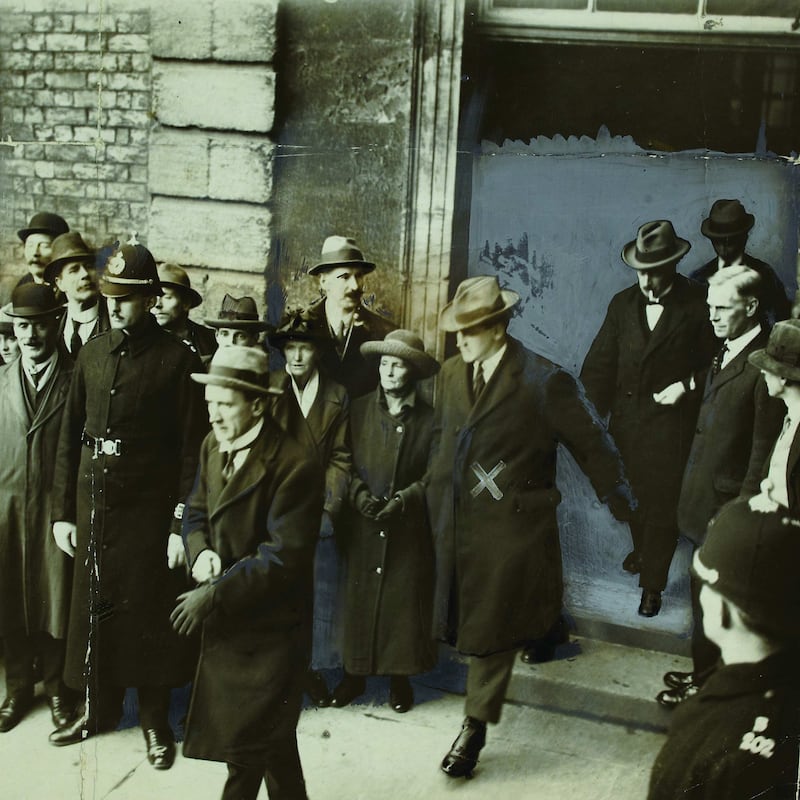
The precise arrangements were still unclear on Sunday night, when an unnamed civil servant told a journalist that it had not yet been confirmed that the ceremony would take place on Monday, and “although it would be a very historic and significant occasion, there would be very little ceremonial about it”.
The expectation was that a representative of the British government, along with some of the heads of government departments, would meet Collins and his colleagues and in a short but formal ceremony, “control of the government of Ireland” would be handed over to the Provisional Government, who met for the first time in the Mansion House at 11am on Monday, January 16th.
Collins was its chairman and took the minutes; the other members were WT Cosgrave, Éamonn Duggan, Patrick Hogan, Fionán Lynch, Joe McGrath, Eoin MacNeill and Kevin O'Higgins. The agenda for their first meeting was straightforward: Collins was confirmed as chairman, and "arrangements were made to visit Dublin Castle at 1.40pm in the afternoon for the purpose of taking over the various departments of State".
The lower yard of the castle was filled with press, security forces, and even the families of officials, all reported to be waiting curiously, while the crowd outside increased in size
This was only settled upon at short notice by telephone on Monday, Collins had been out of the city since Saturday visiting his fiancee, Kitty Kiernan in Longford, but it had been widely flagged in the press that morning.
According to one report, Collins and his colleagues would, “in the next few days or even hours, be entering Dublin Castle as representatives of the Irish nation to deal with that hotbed of bureaucracy, tyranny, reaction and misrule in accordance with the wishes of the Irish people, now its acknowledged masters, and in their name to end forever the iniquities of ‘Castle’ so-called government”.
Dublin Castle was largely hidden behind the intersection of Dame Street and Georges Street. Crowds had assembled nearby from early morning. The Dublin Metropolitan Police regulated traffic in the vicinity. Barbed wire had been removed from the approaches to the Castle and inside some of the canvas screens erected for protecting it from view during the War of Independence were being taken down.
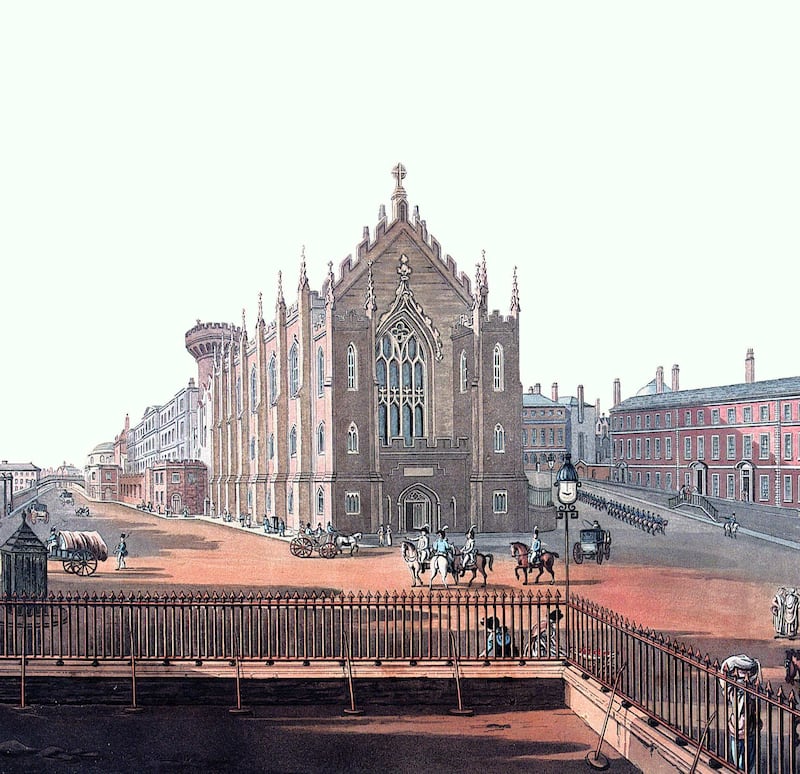
The lower yard of the castle was filled with press, security forces, and even the families of officials, all reported to be waiting curiously, while the crowd outside increased in size as time wore on and made it difficult for military and official vehicles to get through.
Activity mounted into the afternoon. At around 11.30am “a stir was created” as F Company of the Auxiliary Division paraded prior to their disbandment, about which they seemed to be pleased. Collins’s close associate Batt O’Connor, while mingling among the crowd, overheard two “English officers in mufti” reminisce about their experience in Dublin during the Easter Rising; one of them grumbled that with conflict brewing over the Treaty, he thought it likely he’d be back in Dublin within a few months.
At around 12.30pm word went around that the viceroy, Lord FitzAlan, was expected at 1.30pm. The posting of what was erroneously reported as the last Guard at the Castle just before 1pm proved to be of particular interest to onlookers: perhaps 20 soldiers marched from Ship Street barracks to the upper yard, parading in front of the Viceregal (now state) apartments before dispersing to their posts. Numerous onlookers, journalists, photographers and newsreel cameramen were scattered throughout the upper yard in anticipation of the proceedings.
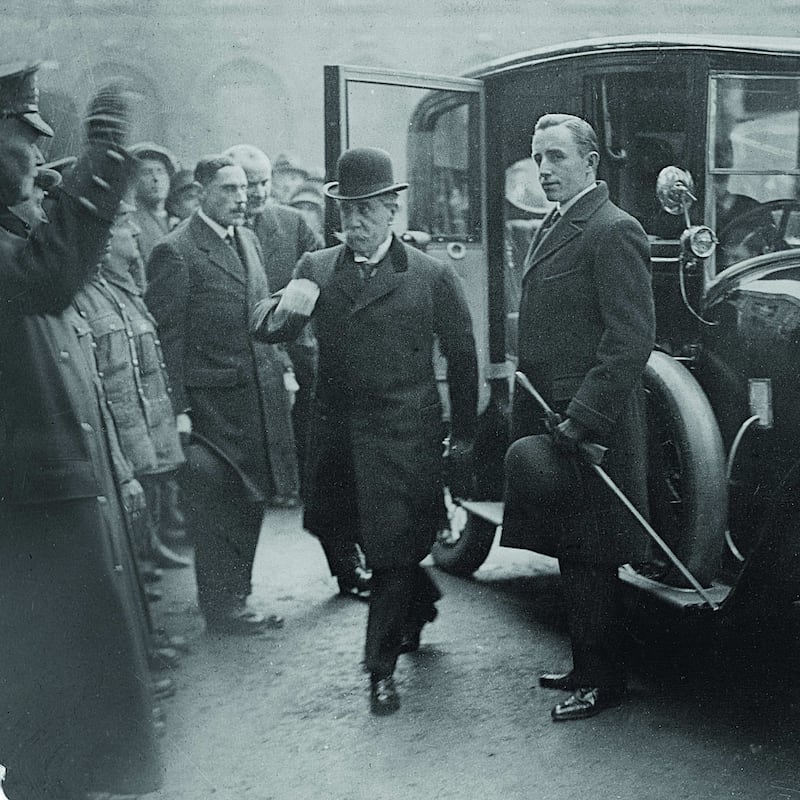
O’Connor heard cheering from Dame Street as the Provisional Government made their way to the Castle from the Mansion House. They arrived at approximately 1.30pm in three cars (apparently taxis) followed by a horse-drawn jarvey and came through the gate at Palace Street before turning right into the expanse of the lower yard.
The interior of the gate was flanked by police, military, photographers, and various onlookers and even a few excited children. In the first car were MacNeill and Collins, who was smiling as he passed; in the second were Duggan and Cosgrave, with the remaining members of the Provisional Government in the third car.
Auxiliaries among the crowd were reported to be in good humour; one was jokingly told to remove a union jack from his tam o’shanter, while others grumbled at being recalled to quarters lest they miss the show.
The three cars ascended the incline of the lower yard and into the upper yard, where they pulled up to the door of the Chief Secretary's Office, in the north-east corner. Collins was the first to alight from the cars; he entered the building swiftly, trying to evade the many photographers in the process. They seem to have arrived on time, although Seán Clancy, who was present as a member of the IRA, later recalled that a British official who commented on Collins allegedly being seven minutes late received the rebuke: "Blast you, sure you people are here 700 years and what bloody difference does seven minutes make now?"
On ascending the staircase inside, Collins and his colleagues (including what one newsreel later dubbed “lady typists”) were greeted by James MacMahon, one of the under-secretaries, who assured them that “You are welcome”, to which Collins replied, without breaking stride, “Like hell we are”.
Outside, many of the clerical staff had been released to watch the proceedings, and some were even taking photographs themselves; there was apparently “a good deal of gaiety and fraternisation” in the upper yard. No flag flew over the Castle, even after FitzAlan arrived a few minutes later to more muted cheers.
He made his way to the Privy Council Chamber located above the arch between the upper and lower yards; its windows conveniently provided a very good view for the spectators outside.
As the Cork Examiner put it: “The simple stateliness of the Chamber with its two great brass chandeliers, pendant over the red cloth-covered table which occupies the centre of the room, must have impressed the new Ministers. The proceedings were private, but it is understood that the Viceroy, as representative of the King, received them as His Majesty would receive new Ministers.”
The drama of seven hundred odd years – was it comedy, farce, or tragedy? – was about to be played out; the curtain was about to fall on the last act and the last scene
FitzAlan met Collins privately first, before meeting the others, "some of whom", noted the senior civil servant George Chester Duggan, "had six months before a price fixed on their heads or were spending a leisured existence in the walls of Mountjoy Prison".
FitzAlan made a short speech “in which he wished the new government success, congratulated them on their action regarding the threatened railway strike, and expressed the hope that they would lead Ireland into new more prosperous days”. Collins was reportedly the centre of attention, “smiling and looking absolutely self-possessed as he met the viceroy”. The heads of the various government departments then arrived, entering from the Chief Secretary’s corridor. According to Duggan:
"The chiefs of the Irish Departments, all save Sir John Anderson, who, with great diplomacy, had found business in London too urgent, had been roped in, and now stood about the Council Chamber, for the most part obviously ill at ease, or regarding the proceedings with that air of cynical detachment which most responsible civil servants in Ireland are bound to cultivate if they intend to pass their life with some slight measure of enjoyment.
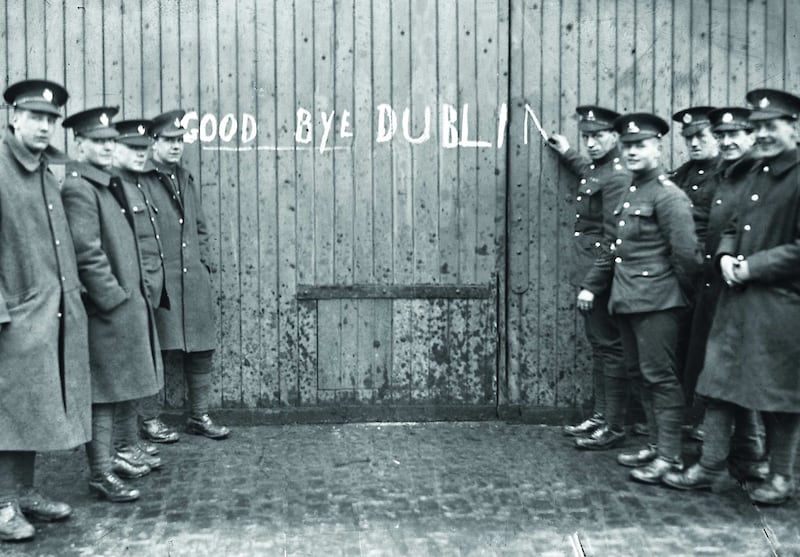
“It was a scene worthy of a painter, fit for the masterhand of some great dramatist. The drama of seven hundred odd years – was it comedy, farce, or tragedy? – was about to be played out; the curtain was about to fall on the last act and the last scene. When it would rise again it would not be on the same play. The characters, the situation, the stuff would be altered.”
The members of the Provisional Government were introduced to their counterparts in the Castle administration. Sir Henry Robinson, the vice-president of the local government board, left his own account of the proceedings:
“On the day fixed for the surrender of the Government to Sinn Féin I received a telephone message to attend at the Council to be introduced to the victors . . . I, being senior in the service, was called in first and was marched round and introduced to each one in turn, just as a newly sworn privy councillor is presented to the other members of the Council. What struck me most was the extreme youth of most of the new Ministers; they seemed scarcely out of their teens, and all looked pale and anxious. No doubt they had been through a period of terrible anxiety, and they certainly looked gloomy and overpowered with the consciousness of responsibility for the future government of the country.
“Michael Collins, their spokesman, however, was cordiality itself, and there was none of the ‘top dog’ attitude about him at all events. I was rather amused to hear people asking each other whether the civil servants would be expected to shake hands with men whose hands were stained with outrage and crime, but, if the civil servants had any doubt on the subject themselves, they were speedily dispelled by Michael Collins, who grasped their hands with his iron grip and shook them warmly with the greatest bonhomie.”
As officially reported to the British cabinet, the “new Government . . . handed to his Excellency a copy of the Treaty, on which their acceptance of its provisions had been endorsed. His Excellency, after congratulating Mr Collins and his colleagues, informed them that they were now duly installed as the Provisional Government, and that the necessary steps would be taken without delay for the transfer to them of the powers and machinery requisite for the discharge of their duties”.
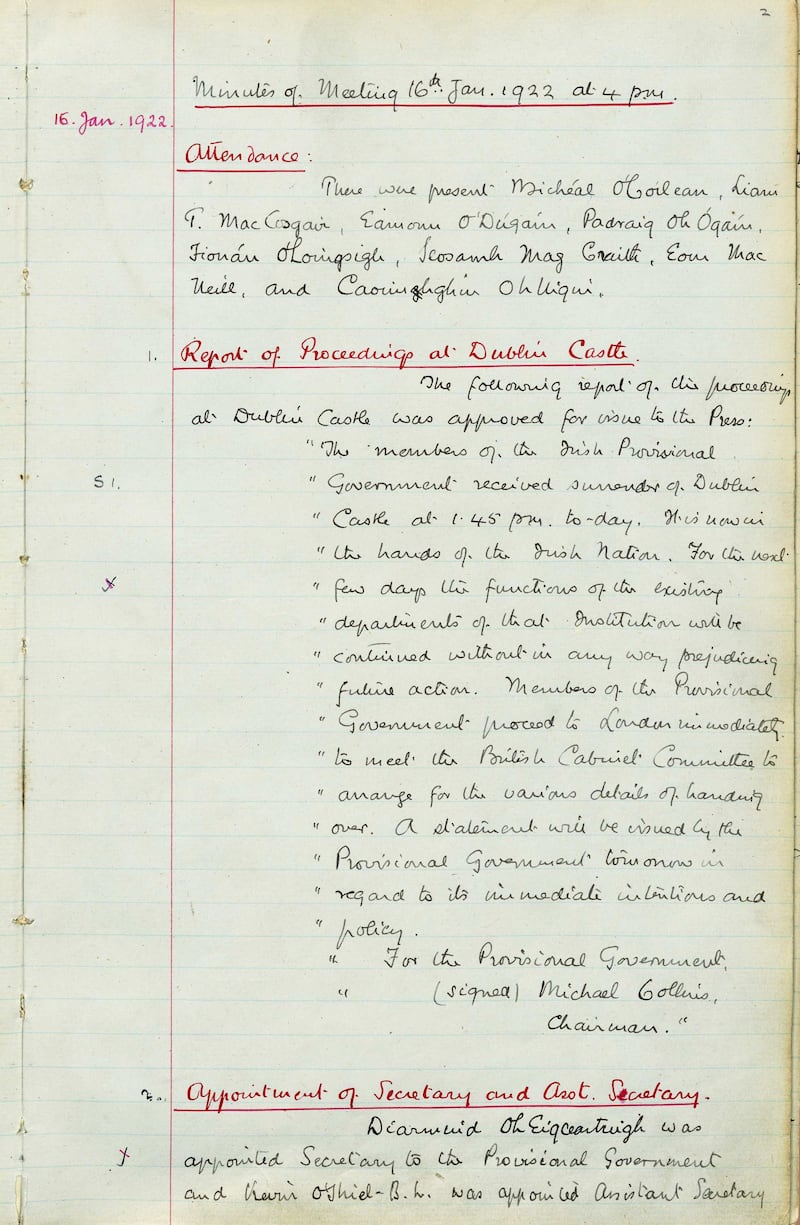
The official British statement issued subsequently wished the new Provisional Government “every success” and expressed “the earnest hope that under their auspices the ideal of a happy, free, and prosperous Ireland would be attained”.
The meeting lasted less than an hour. WT Cosgrave was the first member of the Provisional Government to emerge. They all wore hats and overcoats, some pulling on gloves against what The Irish Times described as “a cold, raw winter day”, others with cigarettes in their mouths, to be greeted with cheers from a crowd that reportedly contained “several American visitors”.
The Provisional Government made their way back to the Mansion House, where Collins sought out Arthur Griffith and announced "Griffith! The Castle has fallen!"
Collins seemed to try to avoid the photographers again as he left, while FitzAlan himself departed after 3pm, without any of the ceremonials that one might expect to have accompanied such an occasion.
It was all sufficiently informal for business to carry on as usual around it: a military lorry outside the privy council suite was being loaded with what the Freeman’s Journal described as “an immense number of volumes, some of them, at any rate, of substantial antiquity” . . . It would be interesting to know if they were amongst the records styled under the old regime ‘Confidential’.”
More prosaically, “the activity in the way of removing stores, bedding and documents went on with increased intensity, and the crowds lined up in Palace Street and Dame Street gave vent to their feelings with good-humoured banter, here and there interspersed with boos when Black and Tans and Auxiliaries appeared. The military were frequently cheered.”
The Provisional Government made their way back to the Mansion House, where Collins sought out Arthur Griffith and announced "Griffith! The Castle has fallen!"
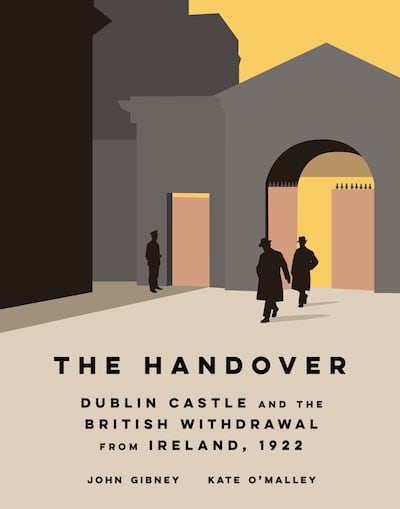
Regardless of whether or not the physical castle was taken over, the government that was traditionally based there was now in Irish hands. Collins’ excitement was real, and it was presumably around this time that he wrote a short but exuberant letter to Kitty Kiernan:
“I am as happy a man as there is in Ireland today. My thoughts just now are all with you, and you have every kind wish and feeling of mine. Have just taken over Dublin Castle and am writing this note while awaiting a meeting of my Provisional Government. What do you think of that?”
John Gibney and Kate O’Malley are historians and assistant editors with the Documents on Irish Foreign Policy series, a partnership of the Royal Irish Academy, the Department of Foreign Affairs and the National Archives. This is an edited extract from The Handover: Dublin Castle and the British Withdrawal from Ireland, 1922, published by the Royal Irish Academy. All proceeds go to Focus Ireland












